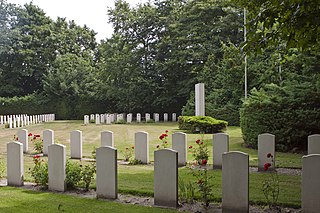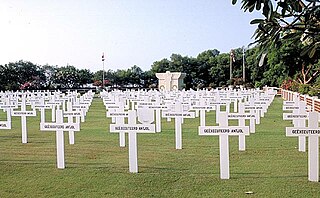
Rhenen is a municipality and a city in the central Netherlands. The municipality also includes the villages of Achterberg, Remmerden, Elst and Laareind. The town lies at a geographically interesting location, namely on the southernmost part of the chain of hills known as the Utrecht Hill Ridge, where this meets the river Rhine. Because of this Rhenen has a unique character with quite some elevation through town.

Surabaya is the capital city of the Indonesian province of East Java and the second-largest city in Indonesia, after Jakarta. Located on the northeastern corner of Java island, on the Madura Strait, it is one of the earliest port cities in Southeast Asia. According to the National Development Planning Agency, Surabaya is one of the four main central cities of Indonesia, alongside Jakarta, Medan, and Makassar. The city had a population of 2,874,314 within its city limits at the 2020 census. With 3,009,286 people living in the city as of mid 2023 and over 10 million in the extended Surabaya metropolitan area, according to the latest official estimate, Surabaya was the second-largest metropolitan area in Indonesia. Surabaya metropolitan is also ASEAN's 7th largest economy ahead of Hanoi.

HNLMS De Ruyter was a light cruiser of the Royal Netherlands Navy. She was originally designed as a 5,000 long tons (5,080 t) ship with a lighter armament due to financial problems and the pacifist movement. Later in the design stage, an extra gun turret was added and the armor was improved. She was the seventh ship of the Dutch Navy to be named after Admiral Michiel Adriaenszoon de Ruyter.

HNLMS Kortenaer was an Admiralen-class destroyer of the Royal Netherlands Navy, named after 17th century Dutch Admiral Egbert Bartholomeusz Kortenaer.

Politionele acties, also politiële acties, in its narrowest definition refers to two major military offensives undertaken by the Netherlands on Java and Sumatra against the Republic of Indonesia during its struggle for independence in the Indonesian National Revolution. In Indonesia they are known collectively as the Agresi Militer Belanda, although the less common translation Aksi Polisionil is also used.
During World War II, the Netherlands was the scene of five years of continuous air warfare between the Allied and the Nazis as the Netherlands lies en route from England to Germany and was designated and built up as the foremost line of Nazi air defence of Germany. Also, in 1944 there was heavy land fighting during the largest Allied airborne attack of the WWII in the south and east of the country in 1944–45. Thousands of airmen, soldiers and others of many nations were killed, and their war graves in some 4,000 locations are in the care of the Dutch War Cemetery Organisation.

Bersiap is the name given by the Dutch to a violent and chaotic phase of the Indonesian National Revolution following the end of World War II. The Indonesian word bersiap means 'get ready' or 'be prepared'. The Bersiap period lasted from August 1945 to November 1947. In Indonesia, other terms aside from bersiap are commonly used, such as gedoran in Depok, ngeli in Banten and surrounding West Java, and gegeran and dombreng in Central Java.

The Indies Monument is a memorial in The Hague in memory of all Dutch citizens and soldiers killed during World War II as a result of the Japanese occupation (1942–1945) of the former Dutch East Indies. It is dedicated to all who died in battle, in prison camps or during forced labor. As stated in the mission statement of the 15 August 1945 Commemoration Foundation, it is also:
A place where you can pass on to your children the part of your childhood spent in the Dutch East Indies

Grebbeberg War Cemetery is a Second World War military war grave cemetery, located on the Grebbeberg, a hill 2 km (1.2 mi) east of Rhenen the Netherlands. The cemetery contains 799 military personnel and one civilian who died during the invasion of the Netherlands by the Germans in May 1940. More than 400 of those interred in the cemetery fell during the Battle of the Grebbeberg.

HNLMS Piet Hein was an Admiralen-class destroyer of the Royal Netherlands Navy, named after 17th century Dutch Admiral Piet Pieterszoon Hein.

HNLMS Java was a Java-class cruiser of the Royal Netherlands Navy. She was sunk during the Battle of the Java Sea on 27 February 1942.

Jacobus Smede "Koos" Sinninghe Damsté (1902–1995) was a lawyer in colonial Indonesia during 1927–1942, prosecutor of Japanese war criminals during 1946–1947, chairman of the national business association in Indonesia during 1948–1954, and head of the Netherlands Security Service during 1955–1967.

Dutch War Cemetery Menteng Pulo, also Dutch Field of Honor Menteng Pulo, is a war cemetery at Jl. Menteng Pulo RT. 3 RW. 12, Menteng Dalam, Tebet, Jakarta in Indonesia. It is one of two Dutch war cemeteries in Jakarta, the other one is Dutch War Cemetery Ancol at Ancol. Dutch War Cemetery Menteng Pulo was built to accommodate the victims of the war from the Japanese occupation during World War II. At present it is maintained by the Netherlands War Graves Foundation, which is an organization that manages all Dutch war cemeteries in the world.

The Belgian Military Field of Honour 1914–1918, is a burial site located at the Oostergaarde Cemetery of the Dutch city Harderwijk in Gelderland. Originally, thirty-six soldiers were buried at the site. Nowadays, 349 Belgian soldiers from the First World War are commemorated. These include 124 individuals whose names feature on a monument because their remains could not be retrieved anymore. The cemetery was inaugurated on 28 September 1963 by the Belgian ambassador. The gravestones are similar to the ones used by the Commonwealth War Graves Commission and are varying from the official Belgian gravestones. The burial site is administered by the Dutch Oorlogsgravenstichting.
The Mariniersbrigade was a marine unit set up by the Dutch government-in-exile during World War II, which existed between 1943 and 1949. It was formed as part of the Dutch contribution to the Allied war effort against Japan and more particularly for the liberation of the Dutch East Indies. The driving force behind its creation was marine colonel M. R. de Bruyne. The Mariniersbrigade became an independently operating unit with a strength of approximately 5,000 men. Capable of amphibious landings, the unit had a core of three infantry battalions, and was further equipped with landing craft, artillery and tanks.

Dutch War Cemetery Candi, also Dutch Field of Honor Candi, is a war cemetery in the hills of Semarang, Central Java in Indonesia. Candi is one of two Dutch war cemeteries in Semarang, the other being Dutch War Cemetery Kalibanteng.

Dutch War Cemetery Kalibanteng, also Dutch Field of Honor Kalibanteng, is a war cemetery in the vicinity of the airport of Semarang, Central Java, in Indonesia. It is one of two Dutch war cemeteries in Semarang, the other being Dutch War Cemetery Candi.

Dutch War Cemetery Pandu, also Dutch Field of Honor Pandu, is a war cemetery in Bandung, West Java, in Indonesia.

Dutch War Cemetery Leuwigajah, also Dutch Field of Honor Leuwigajah, is a war cemetery just outside of Cimahi, West Java, in Indonesia.

Dutch War Cemetery Ancol, also Dutch Field of Honor Ancol, is a war cemetery in Ancol, Jakarta, in Indonesia. It is one of two Dutch war cemeteries in Jakarta, the other being Dutch War Cemetery Menteng Pulo in Tebet. The cemetery was inaugurated on 14 September 1946. More than 2,000 victims of the Pacific War are buried here, including 1,328 members of the resistance against the Japanese occupation of the Dutch East Indies.



















